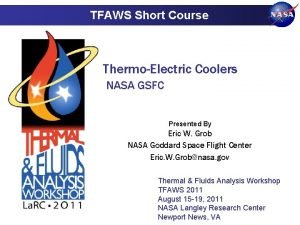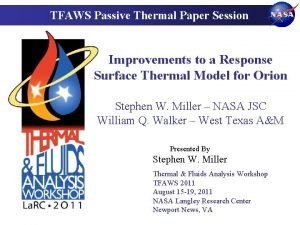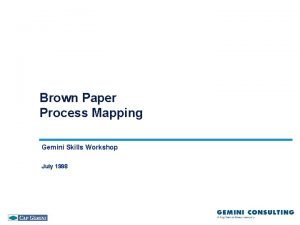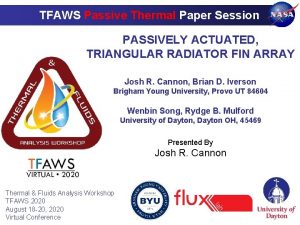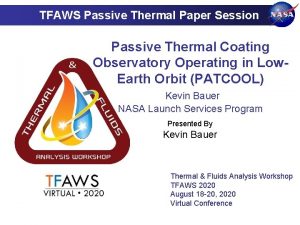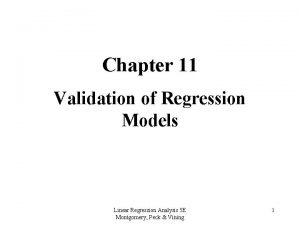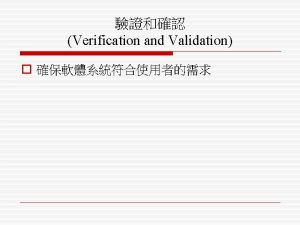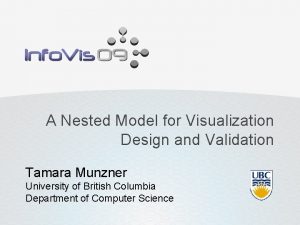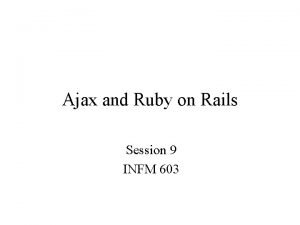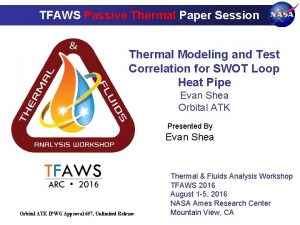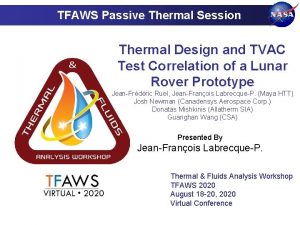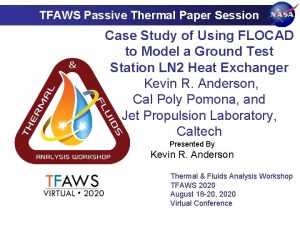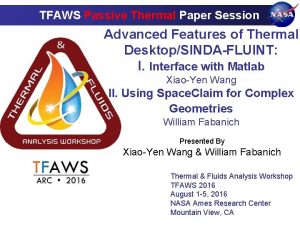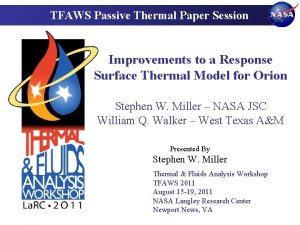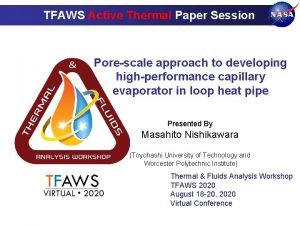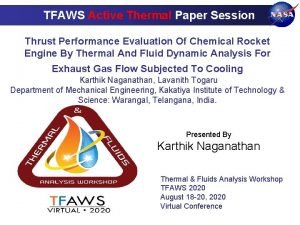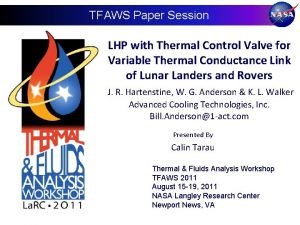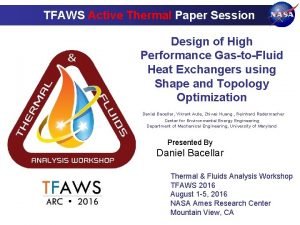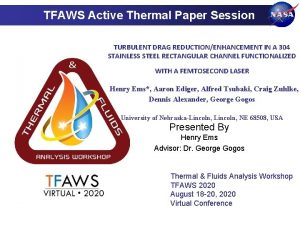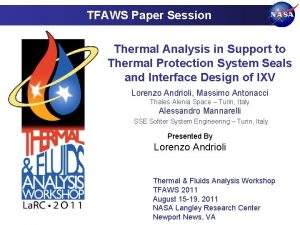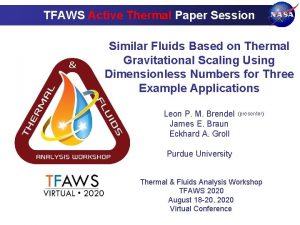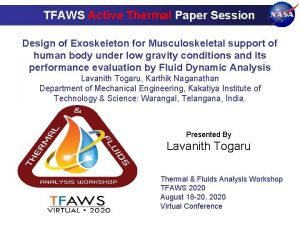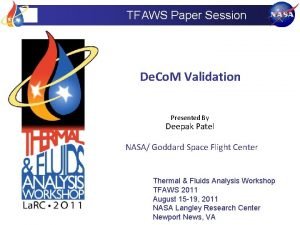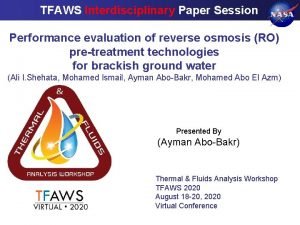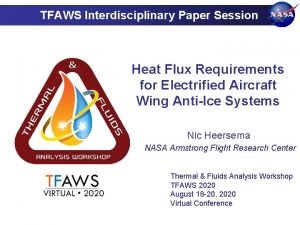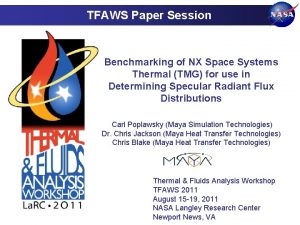TFAWS Passive Thermal Paper Session Model Validation for



















![References [1] W. Q. Walker and J. Iovine, "Comparison of Analysis to the On-Orbit References [1] W. Q. Walker and J. Iovine, "Comparison of Analysis to the On-Orbit](https://slidetodoc.com/presentation_image_h/1ecc29d02e6fd7787826d8273e72dd73/image-20.jpg)

- Slides: 21

TFAWS Passive Thermal Paper Session Model Validation for Bigelow Expandable Activity Module (BEAM) with Stowage Sydney Taylor, Zaida Hernandez, and John Iovine NASA JSC Presented By Sydney Taylor Thermal & Fluids Analysis Workshop TFAWS 2020 August 18 -20, 2020 Virtual Conference

Outline • • • BEAM Background and History On-orbit Flight Data and Model Validation Cases BEAM Model Validation Results BEAM Low IMV Flow Model Results Conclusion TFAWS 2020 – August 18 -20, 2020 2

BEAM Background • • • The Bigelow Expandable Activity Module (BEAM) is a collaboration between NASA and Bigelow Aerospace Berthed to the ISS Node 3 aft port in April 2016 Two year mission to validate overall performance and capability of expandable habitats Expandable habitats offer advantages such as low launch mass, high volume to habitable volume ratios, etc. Configured with wired temperature sensors (WTS) TFAWS 2020 – August 18 -20, 2020 Image Credit: Will Walker 3

BEAM History • • Low flow was observed in starting in August 2017 – ~66 CFM reading on 8/24/2017 – ~45 CFM reading on 9/21/2017 – Cause was determined to be a blockage of the Node 3 aft port fan WTS were converted to wired sensors and cargo bags were prepositioned on 11/21/2017 Cargo bags inside BEAM were filled on 01/24/2019 BEAM flight data temperatures were monitored for 60 days after the cargo stowage was completed TFAWS 2020 – August 18 -20, 2020 4

BEAM with Stowage • • Due to stowage limitations onboard the ISS, the BEAM mission life was extended as a stowage module Previous studies evaluated whether stowage could be added to BEAM without degrading thermal performance – Main concern was condensation forming in the BEAM Approved 109 stowage configuration was completed in January 2019 WTS flight data was monitored for 60 days to confirm that stowage had minimal impact – BEAM did not experience extreme conditions or reduced flow rate during this period TFAWS 2020 – August 18 -20, 2020 5

Model Validation Flight Data Overview • • WTS on-obit data (above) is reported on a quarterly basis • Red represents the aft bulkhead • Blue represents the forward bulkhead • Black represents the air barrier Model is validated with three low temperature events that occurred in 2019 after the approved 109 CTBE stowage was completed TFAWS 2020 – August 18 -20, 2020 6

July 2019 Case • • All time lowest flight temperatures observed on BEAM Low temperature resulted from combination of ISS attitude and lowest annual solar minimum • Maneuver from +XVV to –XVV, with high solar beta exposed BEAM to full ISS shadow Nominal IMV flow rate reading of 106 CFM Min. temperature from flight data: 14 C TFAWS 2020 – August 18 -20, 2020 7

October 2019 Case • • Only low IMV flow rate recorded after stowage • 50 CFM IMV flow reading on 10/21/2019 • Lower flow could have began as earlier as September 2019 Min flight temperature: 14 C TFAWS 2020 – August 18 -20, 2020 8

December 2019 • • Annually recurring cold case for BEAM since 2016 • Cooling trend has been observed since 2016 Occurs due to the solar beta angle approaching the -75 minimum Nominal IMV flow rate (120 CFM) Min. temperature from flight data: 15 C TFAWS 2020 – August 18 -20, 2020 9

Comparison with Historic Flight Data • • Similar times of year and beta angle did not result cold temperatures like those observed in the October 2019 case Annual cold case in December (beta angle -75) observed since 2016 TFAWS 2020 – August 18 -20, 2020 10

Model Overview • • • Working with ISS_V 7 R 1_BEAM_R 6 model Need to change many model parameters to perform date-dependent analysis Need to adjust visiting vehicle configurations for each case BEAM TFAWS 2020 – August 18 -20, 2020 11

Model Overview Parameter Beta Angle (deg) Yaw/Pitch/Roll Solar Constant (BTU/hr/ft 2) OLR (BTU/hr/ft 2) Albedo PTRRJ STRRJ PSARJ SSARJ Flow Rate (CFM) HTC Visiting Vehicles • GMT 200 (July 2019) +72 185. 0/-3. 8/0. 7 GMT 292 (October 2019) -60 -4/-1/1 GMT 350 (December 2019) -75 +4/-1/+1 419 437 447 76 0. 27 -40 +60 Auto-track (AT) AT 76 0. 27 -40 +25 AT AT 76 0. 27 -40 +55 AT AT 120 60 120 HTCs FGB/MRM 1: Soyuz N 1 N: Dragon N 2 N: Cygnus 30 and 60 HTCs FGB/MRM 1: None N 1 N: Dragon N 2 N: None 120 HTCs FGB/MRM 1: None N 1 N: Dragon N 2 N: Cygnus The arrangement of thermal radiators and solar arrays is input into the model for that specific date TFAWS 2020 – August 18 -20, 2020 12

Model Overview Parameter • The visiting vehicle configuration is adjusted depending on what vehicles were visiting in that time period Beta Angle (deg) Yaw/Pitch/Roll Solar Constant (BTU/hr/ft 2) OLR (BTU/hr/ft 2) Albedo PTRRJ STRRJ PSARJ SSARJ Flow Rate (CFM) HTC Visiting Vehicles GMT 200 (July 2019) +72 185. 0/-3. 8/0. 7 GMT 292 (October 2019) -60 -4/-1/1 GMT 350 (December 2019) -75 +4/-1/+1 419 437 447 76 0. 27 -40 +60 Auto-track (AT) AT 76 0. 27 -40 +25 AT AT 76 0. 27 -40 +55 AT AT 120 60 120 HTCs 30 and 60 HTCs 120 HTCs FGB/MRM 1: Soyuz N 1 N: Dragon N 2 N: Cygnus FGB/MRM 1: None N 1 N: Dragon N 2 N: None FGB/MRM 1: None N 1 N: Dragon N 2 N: Cygnus TFAWS 2020 – August 18 -20, 2020 13

Sample Model Output and Approach • • Run each case for 35 -70 hours to observe minimum steady-state temperature Selected coldest WTS location temperature (occurs at aft bulkhead) TFAWS 2020 – August 18 -20, 2020 14

Model Validation Cases Date 19 -Jul 19 -Oct 19 -Dec • • GMT 200 GMT 292 GMT 350 CFM Min Temp °C (baseline) Min Temp °C (degraded) Delta 120 17. 6 14. 3 3. 3 60 17. 4 15. 4 2 30 15. 5 13. 9 1. 6 120 17. 5 14 3. 5 Flight Min Temp Date GMT 201 GMT 291 GMT 355 Flight Min Temp °C IMV Inlet Temp °F 14. 4 72 14. 1 72 15. 0 72 Close agreement (<1 C difference) between model and flight data was achieved by applying a 0. 1 degradation factor to the inside and outside shear coefficients IMV flow rate for GMT 292 was measured at 50 CFM • Only have 30, 60, 90, and 120 HTCs from CFD • Model results for 30 CFM and 60 CFM bound flight data TFAWS 2020 – August 18 -20, 2020 15

Model Validation Cases • • • Only other low flow case occurring between August and September 2017 This case pre-dates November 2017 bag pre-positioning and January 2019 stowage completion Non-degraded model results are in good agreement with flight data Date 19 -Oct 17 -Aug GMT 292 GMT 239 CFM Min Temp °C (baseline) Min Temp °C (degraded) Delta 60 17. 4 15. 4 2 30 15. 5 13. 9 1. 6 60 16. 7 14. 3 2. 4 Flight Min Temp Date GMT 291 GMT 243 Flight Min Temp °C IMV Inlet Temp °F 14. 1 72 16. 3 72 16

Other Factors Examined • Added more isolation from BEAM debris shield • Scrutinized couplings to the soft goods attachment ring and the Flight Releasable Grapple Fixture (FRGF) • Potential shading effects from visiting vehicles • The above factors did not have a significant effect (<0. 5 C) on the BEAM minimum temperatures • Degradation factors of 0. 1, 0. 2, and 0. 3 were studied, with 0. 1 provided the best agreement with flight data TFAWS 2020 – August 18 -20, 2020 17

Low Flow Rate Cases Date GMT CFM Min Temp °C (baseline) Min Temp °C (degraded) Delta IMV Inlet Temp °F 19 -Jul 19 -Jul GMT 200 GMT 200 90 60 30 120 90 60 30 17. 0 15. 8 13. 1 15. 7 15. 0 14. 0 11. 5 13. 7 12. 9 10. 8 12. 6 12. 0 11. 3 9. 6 3. 3 2. 9 2. 3 3. 1 3. 0 2. 7 1. 9 72 72 72 68 68 • These model results were used to provide flight rule update recommendations • IMV inlet temperatures of 68 F and 72 F were evaluated and separate recommendations were made • Auto-track cases examined at 72 F IMV with nominal (120 CFM) and worst case (30 CFM) flow rates TFAWS 2020 – August 18 -20, 2020 18

Conclusions • Good agreement with flight data (< 1 C) was reached with a 0. 1 degradation factor to the shear HTCs for the aft bulkhead • BEAM model is correlated for stowage addition • BEAM model is partially correlated for low IMV flow • Results from the low flow model results were used to provide flight rule update recommendations TFAWS 2020 – August 18 -20, 2020 19
![References 1 W Q Walker and J Iovine Comparison of Analysis to the OnOrbit References [1] W. Q. Walker and J. Iovine, "Comparison of Analysis to the On-Orbit](https://slidetodoc.com/presentation_image_h/1ecc29d02e6fd7787826d8273e72dd73/image-20.jpg)
References [1] W. Q. Walker and J. Iovine, "Comparison of Analysis to the On-Orbit Thermal Performance of the Bigelow Expandable Activities Module, " International Conference on Environmental Systems, Charlestown, SC. , 2017. [2] "BEAM Facts, Figures, FAQs, " NASA, [Online]. Available: https: //www. nasa. gov/feature/beam-facts-figures-faqs. [3] "BEAM Expandable Activity Module, " NASA, [Online]. Available: https: //www. nasa. gov/content/bigelow-expandableactivity-module. [4] L. Carrillo, D. Farner and C. Preston, "ISS Payload Thermal Environments, " Thermal Fluids and Analysis Workshop, 2015. [5] Z. Hernandez, "BEAM Thermal Quarterly Report FY 19, Quarter, " NASA Report, 2019. [6] "B 17 -372 BEAM Dew Point Management. International Space Station Flight Rule. , " \js -ea-fs-01ws 01ESSecure_ServerISS_PTCSFLIGHT_FOLDERSSPX-8. [7] W. Walker, "BEAM Thermal Quarterly Report FY 17, Quarter 4, " NASA Report, 2017. [8] Paul, Tom, “Reduced flowrate case results and heat transfer coefficients on bags, ” Jacobs Presentation, May 17, 2019. TFAWS 2020 – August 18 -20, 2020 20

Questions? TFAWS 2020 – August 18 -20, 2020 21
 Nasa tfaws
Nasa tfaws Tfaws
Tfaws Section 3 using thermal energy
Section 3 using thermal energy Thermal transfer vs direct thermal printing
Thermal transfer vs direct thermal printing Brown paper session
Brown paper session Passive thermal control
Passive thermal control Passive thermal control
Passive thermal control Linear regression model validation techniques
Linear regression model validation techniques Validation plan
Validation plan Pricing model validation
Pricing model validation A nested model for visualization design and validation
A nested model for visualization design and validation English general paper paper 2 comprehension
English general paper paper 2 comprehension Aice general paper 1 exam
Aice general paper 1 exam Rails session model
Rails session model Kontinuitetshantering i praktiken
Kontinuitetshantering i praktiken Typiska novell drag
Typiska novell drag Tack för att ni lyssnade bild
Tack för att ni lyssnade bild Returpilarna
Returpilarna Shingelfrisyren
Shingelfrisyren En lathund för arbete med kontinuitetshantering
En lathund för arbete med kontinuitetshantering Underlag för särskild löneskatt på pensionskostnader
Underlag för särskild löneskatt på pensionskostnader Personlig tidbok
Personlig tidbok
